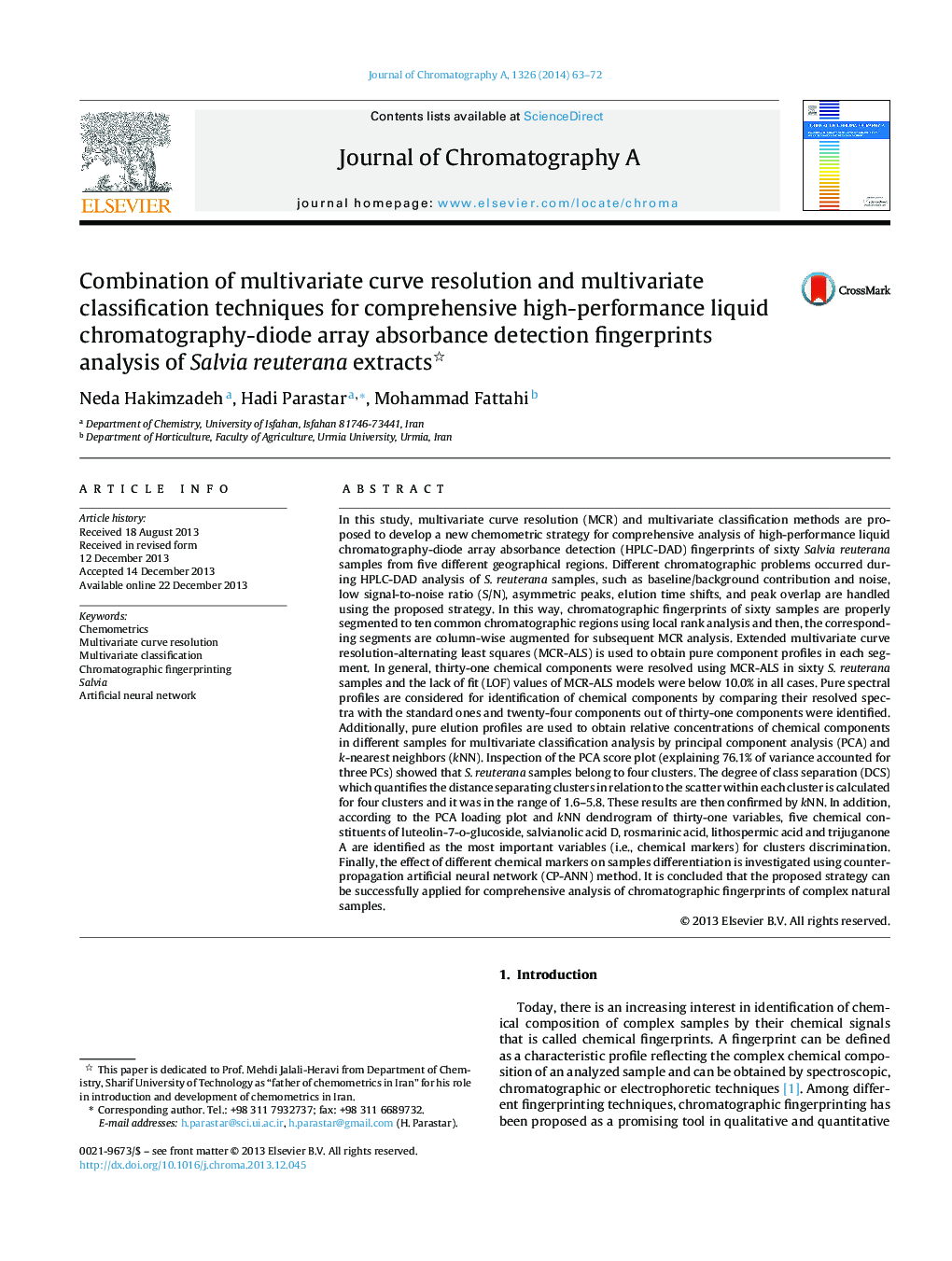| کد مقاله | کد نشریه | سال انتشار | مقاله انگلیسی | نسخه تمام متن |
|---|---|---|---|---|
| 1200787 | 1493600 | 2014 | 10 صفحه PDF | دانلود رایگان |

• Combination of MCR and classification techniques for chromatographic fingerprinting.
• Chromatographic issues were handled in Salvia reuterana HPLC-DAD fingerprints by MCR-ALS.
• Pure elution and spectral profiles were obtained in a very fast manner using MCR-ALS.
• PCA and kNN were used for classification of Salvia reuterana samples using MCR results.
• CP-ANN was used to show the effect of chemical markers in samples differentiations.
In this study, multivariate curve resolution (MCR) and multivariate classification methods are proposed to develop a new chemometric strategy for comprehensive analysis of high-performance liquid chromatography-diode array absorbance detection (HPLC-DAD) fingerprints of sixty Salvia reuterana samples from five different geographical regions. Different chromatographic problems occurred during HPLC-DAD analysis of S. reuterana samples, such as baseline/background contribution and noise, low signal-to-noise ratio (S/N), asymmetric peaks, elution time shifts, and peak overlap are handled using the proposed strategy. In this way, chromatographic fingerprints of sixty samples are properly segmented to ten common chromatographic regions using local rank analysis and then, the corresponding segments are column-wise augmented for subsequent MCR analysis. Extended multivariate curve resolution-alternating least squares (MCR-ALS) is used to obtain pure component profiles in each segment. In general, thirty-one chemical components were resolved using MCR-ALS in sixty S. reuterana samples and the lack of fit (LOF) values of MCR-ALS models were below 10.0% in all cases. Pure spectral profiles are considered for identification of chemical components by comparing their resolved spectra with the standard ones and twenty-four components out of thirty-one components were identified. Additionally, pure elution profiles are used to obtain relative concentrations of chemical components in different samples for multivariate classification analysis by principal component analysis (PCA) and k-nearest neighbors (kNN). Inspection of the PCA score plot (explaining 76.1% of variance accounted for three PCs) showed that S. reuterana samples belong to four clusters. The degree of class separation (DCS) which quantifies the distance separating clusters in relation to the scatter within each cluster is calculated for four clusters and it was in the range of 1.6–5.8. These results are then confirmed by kNN. In addition, according to the PCA loading plot and kNN dendrogram of thirty-one variables, five chemical constituents of luteolin-7-o-glucoside, salvianolic acid D, rosmarinic acid, lithospermic acid and trijuganone A are identified as the most important variables (i.e., chemical markers) for clusters discrimination. Finally, the effect of different chemical markers on samples differentiation is investigated using counter-propagation artificial neural network (CP-ANN) method. It is concluded that the proposed strategy can be successfully applied for comprehensive analysis of chromatographic fingerprints of complex natural samples.
Journal: Journal of Chromatography A - Volume 1326, 24 January 2014, Pages 63–72